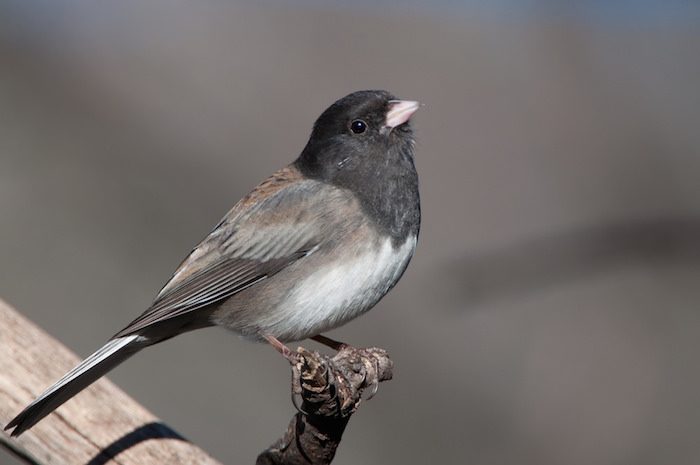The flit of little gray birds with a conspicuous flash of white outer tail feathers signals the arrival of our charming winter visitors, the Dark-eyed Juncos. Look more closely, and you will see a sparrow-shaped bird with a whitish bill and belly, gray central tail feathers, a rusty back and a black head. The female has a similar plumage pattern only more muted. In this part of the country, juncos migrate vertically. They nest in the high mountains – I’ve seen pairs on Mt. Lassen during the summer – then move downward to spend the winter in the valley.
Dark-eyed Juncos build a nest of grass, moss, rootlets, bark and twigs in a shallow depression with overhead protection. The three to five white eggs with reddish-brown markings are laid by the female and incubated by both parents for about 12 days; then the initially naked and helpless young are cared for for another 9-13 days before leaving the nest. Nestling juncos’ feet develop rapidly, so even before they are able to fly, they can run away if threatened by a predator.
Juncos are lively birds to watch at bird feeders this time of year. Most of the adult diet consists of seeds of various kinds. Juncos can also be seen in open woods, undergrowth and roadsides, and can frequently be found in parks such as Lema Ranch. In winter, flocks of 10-30 occupy a foraging territory, so your yard may have its own flock. Within a flock, each bird will have a definite social ranking with the “top bird” getting first crack at the edibles. See if you can tell who is who in your yard!
This common little bird is a “rock star” in scientific circles. Juncos easily accommodate to laboratory aviaries and so have been the subject of avian behavioral studies in courtship and nesting, care of young, and status of individuals in flocks.
Juncos have even been caught in the midst of evolving. At the University of California San Diego, a study is being performed to compare the “city” juncos on campus with “country” juncos in the nearby mountains. Differences have been found in the tolerance for proximity to humans, and those differences have proven to be inheritable. Also associated have been subtle physical differences, which, as time goes on could lead to separate subspecies. Evolution is often thought to take many, many years, but in fact changing conditions frequently cause rapid changes in species. In this case, it’s happening right before the researchers’ eyes!
Different populations in various geographical areas are highly variable, so much so that the western juncos were once split into four distinct species. Deeper studies revealed that the different groups can interbreed freely and are now considered to be one complex species. Thus, juncos are very interesting for genetic investigation.
So, this ordinary familiar little harbinger of winter is actually famous in scientific circles, and a very important bird in the furthering of human knowledge. Enjoy these avian celebrities in your yard and neighborhood until spring when they return to the mountains to produce the next generation.


Comments are closed.